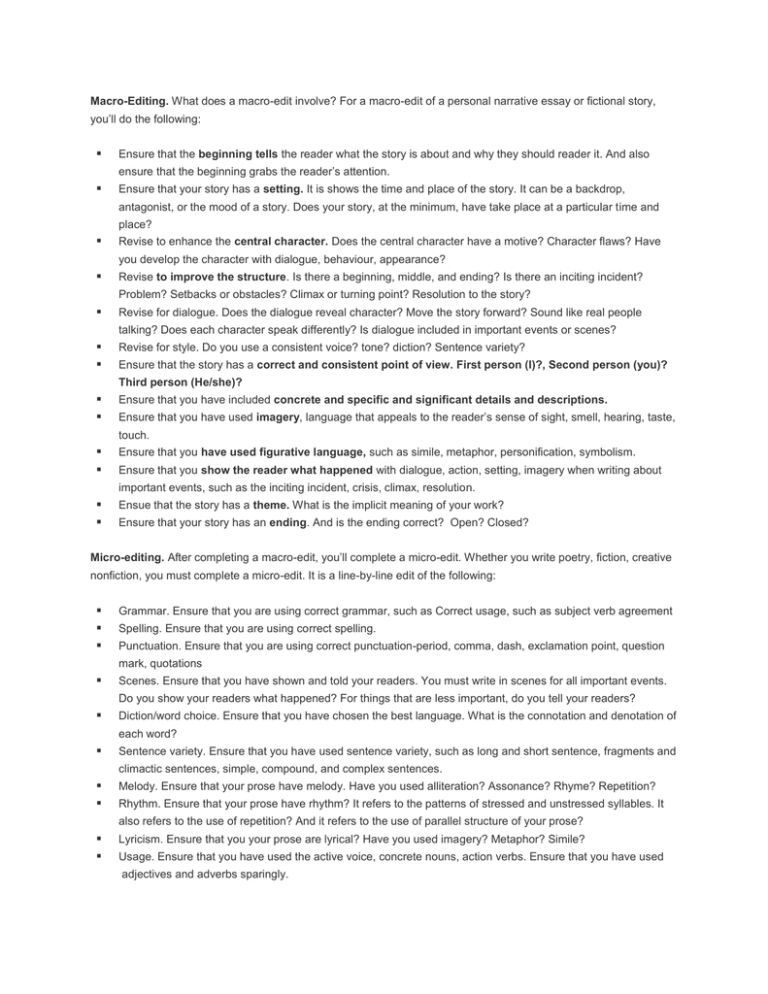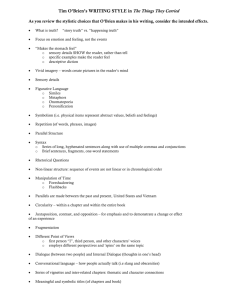Macro & Micro Editing Guide for Narrative Writing
advertisement

Macro-Editing. What does a macro-edit involve? For a macro-edit of a personal narrative essay or fictional story, you’ll do the following: Ensure that the beginning tells the reader what the story is about and why they should reader it. And also ensure that the beginning grabs the reader’s attention. Ensure that your story has a setting. It is shows the time and place of the story. It can be a backdrop, antagonist, or the mood of a story. Does your story, at the minimum, have take place at a particular time and place? Revise to enhance the central character. Does the central character have a motive? Character flaws? Have you develop the character with dialogue, behaviour, appearance? Revise to improve the structure. Is there a beginning, middle, and ending? Is there an inciting incident? Problem? Setbacks or obstacles? Climax or turning point? Resolution to the story? Revise for dialogue. Does the dialogue reveal character? Move the story forward? Sound like real people talking? Does each character speak differently? Is dialogue included in important events or scenes? Revise for style. Do you use a consistent voice? tone? diction? Sentence variety? Ensure that the story has a correct and consistent point of view. First person (I)?, Second person (you)? Third person (He/she)? Ensure that you have included concrete and specific and significant details and descriptions. Ensure that you have used imagery, language that appeals to the reader’s sense of sight, smell, hearing, taste, touch. Ensure that you have used figurative language, such as simile, metaphor, personification, symbolism. Ensure that you show the reader what happened with dialogue, action, setting, imagery when writing about important events, such as the inciting incident, crisis, climax, resolution. Ensue that the story has a theme. What is the implicit meaning of your work? Ensure that your story has an ending. And is the ending correct? Open? Closed? Micro-editing. After completing a macro-edit, you’ll complete a micro-edit. Whether you write poetry, fiction, creative nonfiction, you must complete a micro-edit. It is a line-by-line edit of the following: Grammar. Ensure that you are using correct grammar, such as Correct usage, such as subject verb agreement Spelling. Ensure that you are using correct spelling. Punctuation. Ensure that you are using correct punctuation-period, comma, dash, exclamation point, question mark, quotations Scenes. Ensure that you have shown and told your readers. You must write in scenes for all important events. Do you show your readers what happened? For things that are less important, do you tell your readers? Diction/word choice. Ensure that you have chosen the best language. What is the connotation and denotation of each word? Sentence variety. Ensure that you have used sentence variety, such as long and short sentence, fragments and climactic sentences, simple, compound, and complex sentences. Melody. Ensure that your prose have melody. Have you used alliteration? Assonance? Rhyme? Repetition? Rhythm. Ensure that your prose have rhythm? It refers to the patterns of stressed and unstressed syllables. It also refers to the use of repetition? And it refers to the use of parallel structure of your prose? Lyricism. Ensure that you your prose are lyrical? Have you used imagery? Metaphor? Simile? Usage. Ensure that you have used the active voice, concrete nouns, action verbs. Ensure that you have used adjectives and adverbs sparingly.


